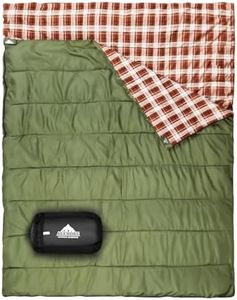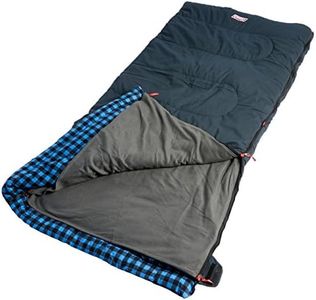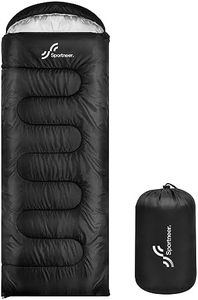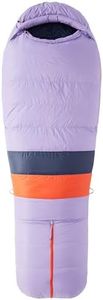We Use CookiesWe use cookies to enhance the security, performance,
functionality and for analytical and promotional activities. By continuing to browse this site you
are agreeing to our privacy policy
10 Best Backpacking Sleeping Bags
From leading brands and best sellers available on the web.Buying Guide for the Best Backpacking Sleeping Bags
Choosing the right backpacking sleeping bag is crucial for a comfortable and safe experience on the trail. A great sleeping bag will keep you warm, fit your needs, and pack down small enough to carry easily. The key is to balance warmth, weight, size, and features according to the type of trips you'll be taking and your personal comfort preferences. Understanding the main specifications will help you find the sleeping bag that best suits your adventures.Temperature RatingThe temperature rating is a guide to how cold it can be before the sleeping bag is no longer keeping you warm. It's important because you want to stay comfortable and safe, but not overheat either. Ratings usually fall into three ranges: summer (above 35°F/1.6°C), three-season (15-35°F/-9 to 1.6°C), and winter (below 15°F/-9°C). Pick a sleeping bag with a temperature rating that's a little lower than the coldest conditions you expect. If you mostly camp in mild weather, a higher-rated (less warm) bag will do. For unpredictable or cold environments, go lower for safety.
WeightWeight is how heavy the sleeping bag is. For backpacking, lighter is usually better because you'll be carrying it all day. Sleeping bags can be under 2 pounds (ultralight), about 2-3 pounds (average), or heavier. Ultralight bags save energy but may sacrifice some comfort or warmth. Heavier bags are fine for short hikes or when comfort matters most. Choose a weight that matches the distance you plan to walk and how much you want to carry.
Insulation TypeThe insulation type decides how the bag keeps you warm: down (from birds) or synthetic (man-made fibers). Down is lighter and packs smaller but loses warmth when wet without special coatings. Synthetic is usually bulkier and heavier but keeps you warm even if damp and dries faster. If you expect a lot of rain or humidity, synthetic might be best. For dry conditions and minimal weight, down is a good pick.
ShapeThe shape affects how the bag fits and holds warmth. Mummy bags are tight and warmest, reducing extra space so you stay warmer and carry less bulk. Rectangular bags give you more room to move, but aren't as warm or light. There are also semi-rectangular and women's specific shapes for more tailored fits. If you move a lot at night or prioritize comfort, go less snug. If you want max warmth and packability, mummy shape is ideal.
Packed SizePacked size is how small the bag gets in your backpack. This matters because backpack space is limited. Down insulation usually packs smallest, while synthetic is a bit bulkier. Compare the packed sizes by looking at the dimensions the manufacturer lists. If you want to carry a tiny pack or have lots of gear, a bag that compresses very small is best. For car camping, size matters less.
Length and FitSleeping bags come in different lengths and some have special fits for men or women. It's important so you don't have extra space that cools you down, or risk not fitting at all. Measure your height and check manufacturer recommendations. Pick a bag close to your height for the best warmth and comfort.
Additional FeaturesFeatures like zippers, hoods, draft collars, and pockets add comfort and utility. Some bags have two-way zippers for venting, or can be zipped to another bag. Hoods and draft tubes help seal in warm air. Think about which extras you’ll really use—are you a cold sleeper or do you hate tight spaces? Pick accordingly for a better night’s sleep outdoors.
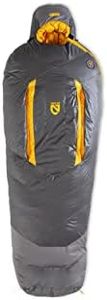

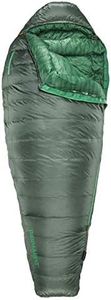




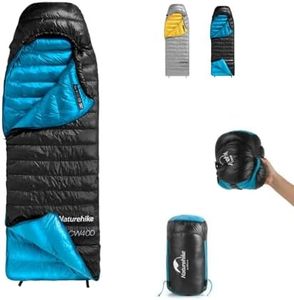
![QEZER Down Sleeping Bag for Kids Adults [ -2~7℃ / -8~0℃,1360g / 1560g ] Ultralight Winter Sleeping Bag 0 Degree for Cold Weather Camping, Hiking and Backpacking Outdoor (Blue 5℃~-3℃ Left-Zip)](https://images-proxy.bestreviews.guide/H2-shuxbN4rYMb2j5aQT5C6B0yY=/0x300/https://m.media-amazon.com/images/I/419dpQNGEHL._AC_CX679_.jpg)
